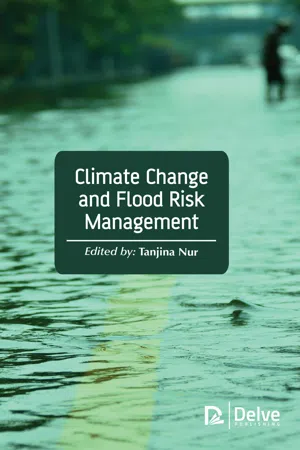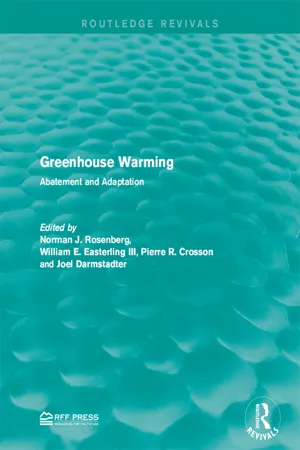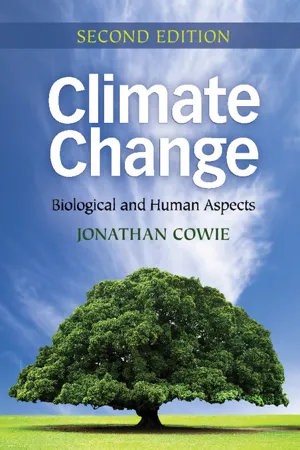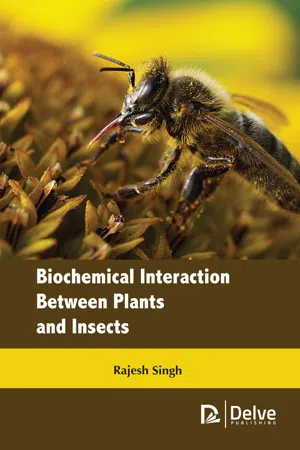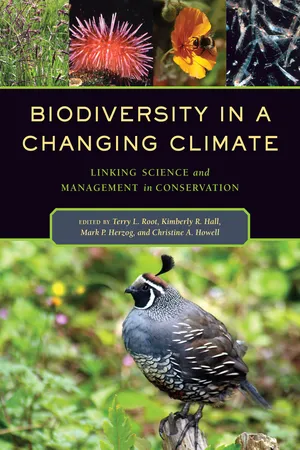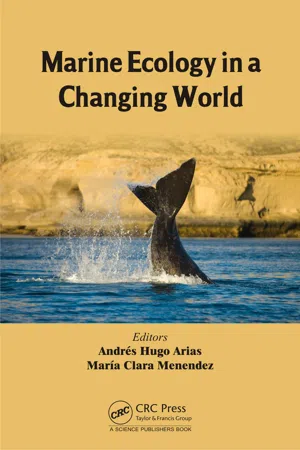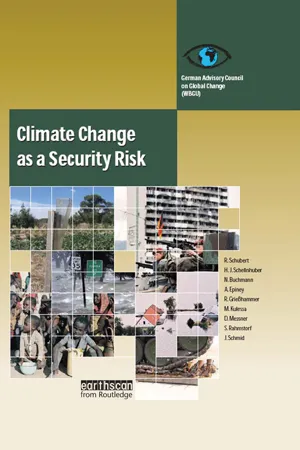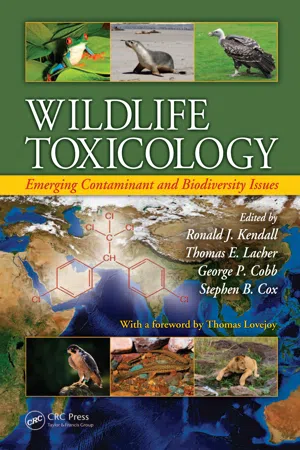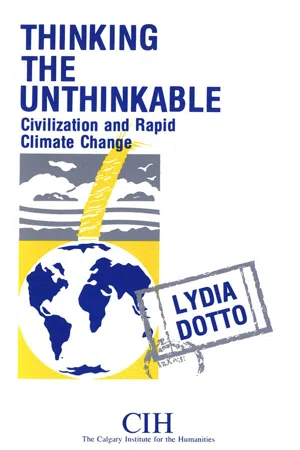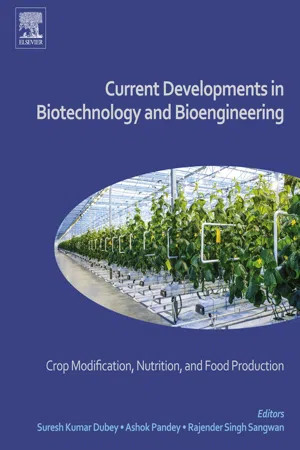Biological Sciences
Effect of Climate Change
The effect of climate change refers to the various impacts of global warming and shifts in weather patterns on the environment, ecosystems, and species. These effects can include changes in temperature, precipitation, and sea levels, leading to shifts in habitats, altered migration patterns, and disruptions to ecological relationships. Overall, climate change poses significant challenges to the stability and functioning of biological systems.
Written by Perlego with AI-assistance
Related key terms
1 of 5
11 Key excerpts on "Effect of Climate Change"
- eBook - PDF
- Tanjina Nur(Author)
- 2019(Publication Date)
- Delve Publishing(Publisher)
However, there is still ambiguity about the extent and rapidity at which climatic conditions will impact our biodiversity and ecosystem services. 3.1 INTRODUCTION Variation in climatic conditions has severe consequences on biophysical atmosphere in terms of discrepancies at the start and end of the season, glacial retreat, reduction in the amount of Arctic sea ice and a rise in sea level. These alterations in the climatic conditions have already left a deep impact on biodiversity at the species level, with respect to phenology, distribution of different ecological population, and level of ecosystem in terms of dispersal, structure & function of atmosphere. Climate leaves very vital environmental impact on our ecosystems. Varying climate affects bionetworks in a variety of ways. For example, rise in temperature may force several species to migrate to higher level of latitudes or elevations where temperatures are more favorable for their survival. In a similar manner, when sea level rises, invasion of saltwater into freshwater system leads some of the key species to displace or die, which in turns leads to the elimination of predators or prey that are critical for the working of existing food chain. Changes in climate does not only disturb our ecosystems and species directly, but it also interacts with other human stressors such as development that hampers the growth of economy. Though most of the minor stressors cause only negligible impact when they act alone, but their cumulative impact may lead to dramatic ecological fluctuations. For example, climatic transformations may intensify the pressure that development of land places on delicate coastal areas. In addition to this, certain area of logged forests may become susceptible to erosion if any alternation in climatic conditions leads to an increase in heavy rain storms. - eBook - ePub
Greenhouse Warming
Abatement and Adaptation
- Norman J. Rosenberg, William E. Easterling III, Pierre R. Crosson, Joel Darmstadter(Authors)
- 2016(Publication Date)
- Routledge(Publisher)
- The fact that the effects of climate change on ecosystems will be superimposed on those of other equally profound environmental agents of change such as forest clearing, air pollution, erosion, and species extinctions. The separation of climatic effects from these other effects through controlled experimentation is difficult if not impossible.
One might conclude that these deficiencies would completely proscribe any attempt to predict the ecological consequences of climatic change. Certainly they suggest that any such predictions should be taken as reasoned speculations at best. However, the recent advances in paleoecological reconstructions of responses of ecosystems to climatic changes of the past, the development of longer-term ecological studies aimed at characterizing change, and the application of tested ecological models (in both paleoeco-logical and long-term studies) have all contributed to our improved capability to judge climatic effects on ecosystems. Using all of these tools, defective as they may be, we undertake an evaluation of the impacts of climate change on ecological systems.Evaluating Impacts of Climate Change on Ecological Systems
We know from paleontological evaluations that, over long time periods (say, millions of years), species can respond to a wide range of climatic and other environmental changes. The panorama of species evolution that one sees when walking through a museum is testimony to the resiliency of biological systems in response to changes that are easily as profound as the climatic changes that might follow a carbon dioxide-induced climatic warming. Since 15,000 years ago, when the continental glaciers began to recede from what is now the contiguous forty-eight states, major plant and animal species have moved their ranges thousands of miles in response to the recession of the glaciers and the consequent climatic change. It would appear that many species are still expanding their ranges in response to the displacement caused by the last glaciation. While it is comforting to realize that there is considerable resiliency in the response of certain species to climate change, it is also important to remember that these responses have occurred on millennial time scales and over unmanaged landscapes. The present situation involves climate change on the scale of a century or less and on landscapes vastly changed by human beings. - eBook - PDF
Climate Change
Biological and Human Aspects
- Jonathan Cowie(Author)
- 2012(Publication Date)
- Cambridge University Press(Publisher)
This means that those studying the biological impacts of climate change have to disentangle these two related phenomena. However, the biological impact of climatic oscillations is relevant to the impact of longer-term 269 6.1 Current biological symptoms of warming climatic change. First, regionally, part of a climatic cycle may go with the direction of longer-term climatic change, so that part of the cycle can provide insights into the regional manifestations of longer-term climatic change. Second, understanding the biological impact of climatic cycles is intrinsically important to regional biomes. Third, longer-term climatic change may result in changes in ocean and atmosphere circulation (see section 6.6.6) and these circulation changes can themselves change the characteristics (or even existence) of regional climatic oscillations. If we are unaware of the current effects of regional oscillations then it will be difficult to discern what biological changes are due to contemporary regional climate systems and what changes are due to longer-term climatic change. Climate change also has some surprisingly unexpected effects on biological sys-tems. Just as the IPCC urge us to be aware of ‘climate surprises’ when considering their gradual warming scenario forecasts, so biologists need to be alert to surprise biological responses to climate change. Climate change can alter things in ways that one might not normally consider important and this includes changing to the wrong type of snow falling. The millions of Britons who regularly travelled into and out of London at the start of the 21st century will be aware of the seemingly joke excuse that rail operators used one winter when they said that the ‘wrong type of snow’ had prevented their track de-icing equipment from working. This made the national head-lines. For some species the right type of snow is of crucial importance. - Rajesh Singh(Author)
- 2019(Publication Date)
- Delve Publishing(Publisher)
Impacts of Climate Change on Biological and Ecological Interaction ... 185 engraver beetles, or ambrosia). It is possible that the abiotic damage comes from the secondary pests (Bjorkman & Niemela, 2015). 9.4. CLIMATE CHANGE AND AGRICULTURE Major research publications report that agriculture is vulnerable to extreme temperatures, droughts, rainfall and floods which reduce crop productivity. The current status of insect pests of horticultural crops and the general economic cost of agriculture in developing countries are projected to increase due to effects of climate change. Countries in Sub-Sahara Africa are vulnerable because most farmers practice small-scale horticulture with traditional technologies dominating the sector and agriculture is rain-fed. The agricultural system is a low input and low output farming practice. The effects of climate change make crops and stored produce susceptible to damage by emerging pest species. Furthermore, there has been a shift in the status of several insect pests in the current scenario of climate change, after the introduction of high-yielding varieties of crops through developments in agricultural technology and modifications of farming practices. In addition, the use of chemicals has led to problems of pesticide resistance, resurgence and contamination of different components of the environment. This has led to build-up of crop pests, with the result that intensity of several pests has increased and many minor pests have assumed the status of major pests (Johnson & Jones, 2017). Several new pest problems have appeared in certain regions for the first time due to creation of favorable environment whereas there has been drastic reduction of related natural enemies. A good example is the emergence of Bactrocera invadens as a key invasive fruit fly pest species that attacks most fruit crops.- eBook - PDF
Biodiversity in a Changing Climate
Linking Science and Management in Conservation
- Terry Louise Root, Kimberly R. Hall, Mark P. Herzog, Christine A. Howell, Terry Louise Root, Kimberly R. Hall, Mark P. Herzog, Christine A. Howell(Authors)
- 2015(Publication Date)
- University of California Press(Publisher)
The legacy of climate change will unfold in biological sys-tems over both short and long timescales. While policy often focuses on the effects of climate change over the next decades and century, a longer-term perspective allows better under-standing of how species and communities will most likely respond fully to changing climates of the future. The fossil record provides such a long-term perspective, and illustrates a variety of impacts associated with climate change. Moreo-ver, the fossil record can show whether the esti-mates of current and future climate change and the corresponding biological responses are within the range of historic variability. In addi-tion to playing a role in extinction events, changes in past climates affected species abun-dances and geographic ranges, population demographics, genetic diversity, and morpho-logical features of individual species such as body size. Over longer time periods, climate affected the macroevolution and species diver-sity of mammals by influencing rates and mag-nitudes of immigration, emigration, extinction, CHAPTER 12 Fossils Predict Biological Responses to Future Climate Change Jessica L. Blois and Elizabeth A. Hadly Key Points • Climate influences mammals and other species in many different ways, with ample evidence in the fossil record supporting effects on abundance, genetics, morphol-ogy, geographic distributions, extinction, and speciation. • The effects of climate change are primarily on population processes, such as abun-dance, genetic, and morphological change, and on range shifts. These interacting processes can affect larger-scale processes such as speciation and extinction. • The fossil record highlights the potential for unexpected and significant changes within future mammalian communities— communities of the future are likely to be very different than those on the landscape today. - eBook - PDF
- Andrés Hugo Arias, María Clara Menendez, Andres Hugo Arias, Maria Clara Menendez(Authors)
- 2013(Publication Date)
- CRC Press(Publisher)
The result of the ecosystem approach has been the development of the current generation of coupled bio-physical models, with a limited ability to respond to environmental change. However, there is a requirement to understand the impact of multiple climatic and anthropogenic drivers on the whole ecosystem, which requires the development of a new generation of end to end models (Parkes et al. 2003). Another driver in model development has been the increase in knowledge of “previously non considered processes”, e.g., the microbial loop (Azam et al. 1983), iron limitation (Martin and Fitzwater 1988) and ocean acidification (Raven et al. 2005). This has led to increasing model complexity, but often at a rate where the speed with which processes are included in models outstrips the modelling community’s ability to realistically parameterize them (Anderson 2005). This is despite the increased availability of integrated data sets, such as the World Ocean Atlas (http://www.nodc.noaa.gov/OC5/WOA05/ pr_woa05.html). One point that engages the effects of climate on the ecosystem and its characteristics is the “regime shift”. The term regime shift has been used to describe large, decadal-scale switches in the abundance and composition of organisms within the ecosystem (e.g., plankton or fish) (Reid et al. 2001). As an example, Venrick et al. (1987) reported an increase in phytoplankton biomass before and after this period, which they attributed to a modification of atmospheric circulation. Spatial gradients in sea level pressure increased the shift. Increased strength and frequency of storminess and westerly winds 18 Marine Ecology in a Changing World allowed a deeper mixing and a transfer of more nutrients to the surface. This climatic forcing modified the carrying capacity of the central North Pacific gyre, contributing to an increase in the abundance of fishes such as the Alaskan salmon and cod, and a decrease in the abundance of shrimps. - eBook - ePub
- Hans Joachim Schellnhuber(Author)
- 2010(Publication Date)
- Routledge(Publisher)
Impacts of climate change on thebiosphere and human society5This section discusses expected climatic changes and their consequences based on data from two sources: observed trends in the period 1975–2004, and evaluation of the results of a series of model scenarios. This then serves as the basis for identifying regions in which particularly critical developments are to be expected (Chapter 7 ).5.1Changes in climatic parameters
WBGU assumes that climate change will become the most important driver of global environmental changes in the coming decades. Added to this are the effects of direct human interventions in the environment, which vary from region to region, e.g. river channel alignment that exacerbates flood risk, and unsustainable land-use practices that lead to soildegradation.Simulations of regional climatic changes are fundamentally more uncertain than global mean values, because regional climate is heavily influenced by atmospheric and oceanic circulation (e.g. by the prevailing weather situations and wind directions). Changes in these have scarcely any impact on global mean values, but at regional level they represent a factor whose influence is highly unpredictable. Furthermore, there is greater uncertainty when it comes to calculating precipitation than when calculating temperature, because the processes that determine rainfall involve complex physics, while temperature is the outcome of a relatively straightforward thermal balance. This is why there is considerable uncertainty regarding regional precipitation scenarios in particular, and scenarios may vary quite markedly depending on the model used.Similarly, extreme events such as tropical cyclones are also captured less well by climate models because the spatial resolution of global climate models is mostly inadequate for describing them, and the relevant processes are strongly non-linear.This section discusses developments that can be considered robust and reliable. The discussion also touches on other risks about which there is still considerable uncertainty given the current state of knowledge. However, ‘one-off’ developments that arise in only one or other of the models are not discussed here. WBGU has opted to focus instead on phenomena occurring in at least several of the climate change models. Reference is also made to observational data and physical contexts in order to underpin the plausibility of the risks under discussion. This does not make it possible to draw up definiteforecasts regarding where and when particular critical developments will occur, but plausible threats can be outlined. - eBook - PDF
Ecological Consequences of Climate Change
Mechanisms, Conservation, and Management
- Erik A. Beever, Jerrold L. Belant(Authors)
- 2016(Publication Date)
- CRC Press(Publisher)
..................................................................... 115 Attribution.of.Range.Shifts.to.Effects.of.Climate.Change. .................................... 116 Mechanisms.behind.Uphill.Range.Shifts. ............................................................... 119 Modeling.Effects.of.Uphill.Range.Shifts.on.Biodiversity. ..................................... 121 Synthesis,.Future.Directions,.and.Conservation. .................................................... 123 Acknowledgments. .................................................................................................. 125 Summary. ................................................................................................................ 126 References. .............................................................................................................. 126 108 Ecological Consequences of Climate Change track.the.distribution.of.suitable.climates.more.readily.by.colonizing.natural.habitats. in.mountains.rather.than.by.moving.across.lowlands.dominated.by.intensive.human. land.use,.where.the.distributions.of.many.species.are.failing.to.keep.up.with.climate. change.(Warren.et.al . .2001;.Menéndez.et.al . .2006) . Indeed,.some.of.the.first.and.most.widely.cited.examples.of.ecological.responses.to. climate.change.refer.to.elevational.changes.in.species.distributions . .Parmesan.(1996,. 2005).showed.that.the.average.elevation.of.populations.of.the.butterfly. Euphydryas editha .in.western.North.America.shifted.upward.by.124.m.during.the.twentieth.cen-tury.(the.average.latitude.also.shifted.north.by.92.km),.as.isotherms.shifted.uphill.by. 105.m . .Pounds.et.al . .(1999).recorded.increasing.domination.of.the.bird.and.herptile. fauna.of.Monteverde.National.Park.in.Costa.Rica.by.species.associated.with.lower.ele-vations,.consistent.with.increasingly.dry.local.conditions.between.the.1980s.and.1998 . - eBook - PDF
Wildlife Toxicology
Emerging Contaminant and Biodiversity Issues
- Ronald J. Kendall, Thomas E. Lacher, George C. Cobb, Stephen Boyd Cox, Ronald J. Kendall, Thomas E. Lacher, George C. Cobb, Stephen Boyd Cox(Authors)
- 2016(Publication Date)
- CRC Press(Publisher)
The variety of impacts this will have on the species and ecosystems of the planet is impossible to fully gauge, but evidence from past changes, computer simula-tions, and current observations strongly suggest what may lie ahead for wildlife. 6.6 RESPONSE OF PLANTS AND ANIMALS TO CLIMATE CHANGE The fossil record suggests that one of the dominant responses of species to past climate change was changing ranges (Huntley and Birks 1983). For instance, tree species in North America underwent a dramatic northward range shift as the con-tinent emerged from the last ice age (Overpeck et al. 2003). But beyond ice ages, many species from all parts of the world have responded to many types of climate change (warming, cooling, drying, increased rainfall) by adjusting their physical location to match their preferred climate tolerances. This leads us to expect that a major response to human-induced climate change should be species’ range shifts (Hannah, Lovejoy et al. 2005). And indeed, many such range shifts are now being observed. 6.6.1 R ANGE AND P OPULATION E FFECTS One of the first demonstrations of a range shift resulting from climate change is from a butterfly found in western North America. Checkerspot butterflies ( Euphydras ) had been known for some time to be vulnerable to population crashes or booms resulting from weather conditions. Edith’s checkerspot butterfly ( Euphydras spp.) is responding to changing climate by undergoing a major range shift (Parmesan 1996). The entire range of Edith’s checkerspot has been studied—one of the few species for which such a complete range shift has been established (Figure 6.5). Populations of Edith’s checkerspot in the south (Mexico) and in the lowlands are disappearing faster than populations in the north and in the uplands (Parmesan 1996). Continuation of this trend would lead to loss of the lowland and southern ranges, and increases in range at upper elevations and poleward—exactly the pat-tern expected with climate change. - eBook - PDF
Thinking the Unthinkable
Civilization and Rapid Climate Change
- Lydia Dotto(Author)
- 2006(Publication Date)
- Wilfrid Laurier University Press(Publisher)
Chapters SOCIAL AND PSYCHOLOGICAL EFFECTS OF RAPID CLIMATE CHANGE Complex societies have been collapsing almost as long as they have existed. The history and archaeology of these societies provide us with considerable knowledge of what happens when political and economic systems disintegrate. —anthropologist Joseph Tainter Until recently, studies of large-scale or rapid changes in the earth's climate have concentrated largely on the potentially catastrophic physical and biological effects of such changes. This is not surprising, since it stems from a natural desire to understand the problems that confront us—or whether, in fact, a problem even exists. In the next chapter, the extent and nature of the major environmental problems we face are discussed in more detail. But, in an important sense, the exact nature of the problem doesn't matter because it's clear that any severe wide-scale environmental or climatic upheaval—whether natural or caused by human activity—will affect much more than the physical and biological world. It will also cause a cascade of far-reaching disruptions in our political and economic systems and create possibly unprecedented social and psychological stresses that will undermine efforts at recovery—if, indeed, recovery is possible at all. Many human societies have faced environmental disaster in the past. Some have survived, others have not. Can we learn from their experience? Can their response to catastrophe give us an insight into the limits of our resiliency in coping with such changes in the future? Can it give us any clues about the kinds of strategies that might reduce our vulnerability to such changes? These are questions that have drawn the social sciences and humanities into the debate over humanity's ability to adapt to environ-mental and climatic stress. It is in the examination of humanity's 'survival track record' that the social sciences and humanities can contribute to our search for coping strategies for the future. - eBook - ePub
Current Developments in Biotechnology and Bioengineering
Crop Modification, Nutrition, and Food Production
- Suresh Kumar Dubey, Ashok Pandey, Rajender Singh Sangwan(Authors)
- 2016(Publication Date)
- Elsevier(Publisher)
[67] . Therefore, integrated research into multitrophic interactions under changing climatic conditions is essential for understanding the real response of agroecosystems to such changing conditions and for developing innovative climate-resilient strategies for harnessing such beneficial interactions as low-input biotechnology to enhance the productivity of agroecosystems under changing climatic conditions.2.4. Projected Impact of Climatic Changes on Crop Production
Climate change is projected to undermine food security. Because of projected climate change by the mid-21st century and beyond, for wheat, rice, and maize in tropical and temperate regions, climate change without adaptation is projected to affect production negatively for local temperature increases of 2°C or more above late–20th century levels, although individual locations may benefit. Global temperature increases of about 4°C or more above late–20th century levels, combined with an increasing food demand, would pose large risks to food security globally. Climate change is projected to reduce renewable surface water and groundwater resources in most dry subtropical regions [48] . Global wheat production is estimated to fall by 6% for each degree Celsius of further temperature increase and become more variable over space and time [68] .Comprehensive reviews [23 ,52 ,69 ] around the globe point to clear evidence of a decline in the yields of important cereal crops under climate change conditions. Overall, the agronomic modeling literature at a global level indicates the potential negative effects of climate change. Selective reports published to date are shown in Table 2.1 , some of which have been discussed in this chapter. Although an increase in CO2 is likely to be beneficial to several crops, associated increases in temperatures, and increased variability in rainfall would considerably affect food production. Several studies indicate a considerable probability of loss of global crop production with increases in temperature. There are a few studies on this theme and they generally confirm a similar trend of agricultural decline with climate change [70] . Lobell and Gourdji [52] reviewed global scale grain productivity and found that over the next few decades, CO2 trends will likely increase global yields by roughly 1.8% per decade. At the same time, warming trends are likely to reduce global yields by roughly 1.5% per decade without effective adaptation, with a plausible range from roughly 0% to 4%. The upper end of this range is half of the expected 8% rate of gain from technological and management improvements over the next few decades. Many global change factors that will likely challenge yields, including higher O3
Index pages curate the most relevant extracts from our library of academic textbooks. They’ve been created using an in-house natural language model (NLM), each adding context and meaning to key research topics.
